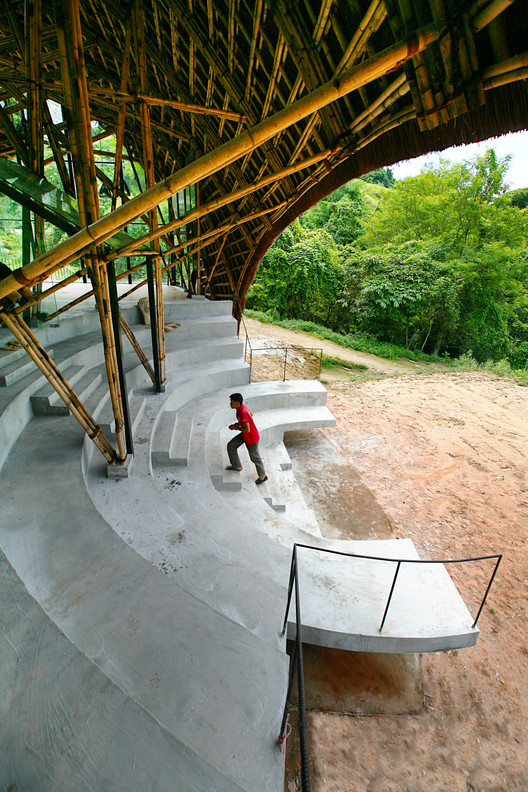Kuhon
2016-05-24 19:00
© Hiroshi Ito
伊藤广史


架构师提供的文本描述。这个项目是一座佛教寺庙,也是佛教徒“若道书”的骨盆。该遗址位于长崎Sasebo坡上,周围是一个密集的居民区。此外,骨盆、庙宇和住宅被池塘隔开,阳光的反射透过玻璃窗投射到骨盆的地板上。一般来说,“若多书”的庙宇都是面向东方的,所以在主殿祈祷的时候,祈祷者自然会面对西方天堂(若多教派的一个天堂,它应该位于我们世界的最西边)。相反,由于斜坡的方向,这座寺庙朝西。然而,在庙门内嵌的栅格内部加上一层朱砂色的饰面,并借助透过楼梯和庙宇的落日的光线,楼梯空间、庙宇和正厅都用朱砂点亮。
Text description provided by the architects. This project is a Buddhist temple and ossuary for the “Jodo-shu”, a Buddhist sect. The site is located on a slopein Sasebo, Nagasaki, surrounded by a dense residential area. In addition, the ossuary, the temple premises and the residences are separated by ponds, and the reflection of the sunlight is thrown on the floor of the ossuary through the glass windows. Generally, temples of the “Jodo-shu” are planned to face east so that when praying at the main hall, the prayers would naturally face the Western Paradise (a paradise in the Jodo sect which is supposed to be located in the far west of our world). In contrast, due to the direction of the slope, this temple faces west. However, by adding a cinnabar-coloured finish to the inner part of the grid inset in the temple gate, and with the help of the light of the setting sun through the stairway and the temple premises, the stairway space, the temple premises and the main hall are all lit up in cinnabar.
© Hiroshi Ito
伊藤广史


圣佛之地
Holy Buddha Land
整个骨室和祈祷厅的设计都是以佛教徒的信仰为指导的,运用了当代的词汇。这里的建筑遵循一个叙事,赋予每个轴,方向,空间,材料和建筑的体积。根据佛陀的信仰,骨室的外观必须面对西方,圣地,这样冬青光就会温暖和安慰房屋里的灵魂。光的使用遵循这一条件,但作为一个机会,提供了一个庄严的气氛,一个休息的空间,为骨。
The whole design of the ossuary and the prayer hall is directed by Buddist beliefs, applying a contemporary vocabulary. Architecture here follows a narrative that gives sense to every axis, orientation, space, material and volume of the buildings. According to Buddist beliefs, the facade of the ossuary has to face West, the holy land, this way the holly light warms and consoles the souls in houses. The use of light follows this condition and is nevertheless used as an opportunity to provide a solemn atmosphere inside, a restful space for the ossuary.


斜坡上的建筑物
Building on the Slope
现有的墓地是在一个人造的露台上,这是危险的恶化。然而,寺庙缺乏资金。提出了一种钢筋混凝土结构,作为一个门和一个有450个隐窝空间的骨室。120个空间重新安置了现有的墓地,其余的被出售以资助新的主大厅。与混凝土骨室相比,主厅是一种轻钢结构。在夏天,门厅的功能完全打开空间,凉风。
The existing graveyard was on a man-made terrace that was dangerously deteriorated. However, the temple was lacking funds. A reinforced concrete structure was proposed as a gate and an ossuary with 450 crypt spaces. 120 spaces re-accommodated the existing graveyard, and the rest were sold to fund the new main hall. In contrast to the concrete ossuary, the main hall is a light steel structure. In summer, doors of the hall function to completely open the space to cooling breezes.
© Hiroshi Ito
伊藤广史


在遗址的底部,有一座寺庙的门附在一座小房子上,通过这扇门,一条楼梯就会把我们引到庙宇。庙宇的正厅是在殿前规划的,在殿的两侧都布置了院长和副院长的住所。然而,由于这些住宅被墙隔墙所掩藏,因此没有人能注意到庙宇中的住宅。
At the bottom of the site, a temple gate attached to a charnel house is arranged, and through this gate, a stairway would lead us up to the temple premises. The main hall of the temple is planned at the front of the premises, and on both sides of the premises, the residences for the chief abbot and vice-chief abbot are arranged. However, as these residences are hidden by wall partitions, no one could notice the dwellings from the temple premises.
© Hiroshi Ito
伊藤广史


池塘是一种精神元素。这是这个世界与另一个世界的象征性分离。骨盆、庙宇和住宅被池塘隔开。阳光的反射透过玻璃窗投射到骨盆的地板上。
The pond is a spiritual element. It is a symbolic separation between this world and the next. The ossuary, the temple premises and the residences are separated by ponds. The reflection of the sunlight is thrown the floor of the ossuary through the glass windows.
© Hiroshi Ito
伊藤广史


可操作Verandah
Openable Verandah
对寺庙的位置进行了仔细的研究,利用它在山上的高位置,利用自然通风来冷却夏季的空间。这个空间的设计采用了日本传统房屋的理念:英加瓦(Engawa),这是一个阳台,后面有鞋幕(纸做的推拉门)。
The location of the temple was carefully studied to take advantage of its high position on the hill and make use of natural ventilation for cooling the space during summer time. The space was designed adopting an idea from traditional Japanese houses: the engawa, a veranda with shoji screens (sliding doors made of paper) behind.


















Architects Furuichi and Associates
Location Sasebo, Nagasaki Prefecture, Japan
Category Temple
Project Year 2003
Photographs Hiroshi Ito































